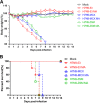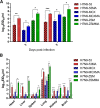Multiple amino acid substitutions involved in the adaption of three avian-origin H7N9 influenza viruses in mice
- PMID: 30621708
- PMCID: PMC6323857
- DOI: 10.1186/s12985-018-1109-1
Multiple amino acid substitutions involved in the adaption of three avian-origin H7N9 influenza viruses in mice
Abstract
Background: Avian influenza A H7N9 virus has caused five outbreak waves of human infections in China since 2013 and posed a dual challenge to public health and poultry industry. The number of reported H7N9 virus human cases confirmed by laboratory has surpassed that of H5N1 virus. However, the mechanism for how H7N9 influenza virus overcomes host range barrier has not been clearly understood.
Methods: To generate mouse-adapted H7N9 influenza viruses, we passaged three avian-origin H7N9 viruses in mice by lung-to-lung passages independently. Then, the characteristics between the parental and mouse-adapted H7N9 viruses was compared in the following aspects, including virulence in mice, tropism of different tissues, replication in MDCK cells and molecular mutations.
Results: After ten passages in mice, MLD50 of the H7N9 viruses reduced >750-3,160,000 folds, and virus titers in MDCK cells increased 10-200 folds at 48 hours post-inoculation. Moreover, the mouse-adapted H7N9 viruses showed more expanded tissue tropism and more serious lung pathological lesions in mice. Further analysis of the amino acids changes revealed 10 amino acid substitutions located in PB2 (E627K), PB1 (W215R and D638G), PA (T97I), HA (H3 numbering: R220G, L226S, G279R and G493R) and NA (P3Q and R134I) proteins. Moreover, PB2 E627K substitution was shared by the three mouse-adapted viruses (two viruses belong to YRD lineage and one virus belongs to PRD lineage), and PA T97A substitution was shared by two mouse-adapted viruses (belong to YRD lineage).
Conclusions: Our result indicated that the virulence in mice and virus titer in MDCK cells of H7N9 viruses significantly increased after adapted in mouse model. PB2 E627K and PA T97A substitutions are vital in mouse adaption and should be monitored during epidemiological study of H7N9 virus.
Keywords: H7N9 influenza virus; adaption; amino acid substitution; mouse; virulence.
Conflict of interest statement
Ethics approval and consent to participate
The animal study was supervised by the Institutional Animal Care and Use Committee of the Sun Yat-sen University and performed in accordance with the regulation and guidelines of this committee (Permit number: SYSU-IACUC-2018-000109).
Consent for publication
All authors consent for publication.
Competing interests
The authors declare that they have no competing interests.
Publisher’s Note
Springer Nature remains neutral with regard to jurisdictional claims in published maps and institutional affiliations.
Figures




Similar articles
-
Mutations during the adaptation of H7N9 avian influenza virus to mice lungs enhance human-like sialic acid binding activity and virulence in mice.Vet Microbiol. 2021 Mar;254:109000. doi: 10.1016/j.vetmic.2021.109000. Epub 2021 Jan 20. Vet Microbiol. 2021. PMID: 33515926
-
Mouse-adapted H9N2 influenza A virus PB2 protein M147L and E627K mutations are critical for high virulence.PLoS One. 2012;7(7):e40752. doi: 10.1371/journal.pone.0040752. Epub 2012 Jul 10. PLoS One. 2012. PMID: 22808250 Free PMC article.
-
Emergence and Adaptation of a Novel Highly Pathogenic H7N9 Influenza Virus in Birds and Humans from a 2013 Human-Infecting Low-Pathogenic Ancestor.J Virol. 2018 Jan 2;92(2):e00921-17. doi: 10.1128/JVI.00921-17. Print 2018 Jan 15. J Virol. 2018. PMID: 29070694 Free PMC article.
-
Low Polymerase Activity Attributed to PA Drives the Acquisition of the PB2 E627K Mutation of H7N9 Avian Influenza Virus in Mammals.mBio. 2019 Jun 18;10(3):e01162-19. doi: 10.1128/mBio.01162-19. mBio. 2019. PMID: 31213560 Free PMC article.
-
Evolution and Adaptation of the Avian H7N9 Virus into the Human Host.Microorganisms. 2020 May 21;8(5):778. doi: 10.3390/microorganisms8050778. Microorganisms. 2020. PMID: 32455845 Free PMC article. Review.
Cited by
-
A Strand-Specific Quantitative RT-PCR Method for Detecting vRNA, cRNA, and mRNA of H7N9 Avian Influenza Virus in a Mouse Model.Viruses. 2025 Jul 17;17(7):1007. doi: 10.3390/v17071007. Viruses. 2025. PMID: 40733623 Free PMC article.
-
Staphylococcus aureus Host Tropism and Its Implications for Murine Infection Models.Int J Mol Sci. 2020 Sep 25;21(19):7061. doi: 10.3390/ijms21197061. Int J Mol Sci. 2020. PMID: 32992784 Free PMC article. Review.
-
Animal Models Utilized for the Development of Influenza Virus Vaccines.Vaccines (Basel). 2021 Jul 14;9(7):787. doi: 10.3390/vaccines9070787. Vaccines (Basel). 2021. PMID: 34358203 Free PMC article. Review.
-
Dynamic PB2-E627K substitution of influenza H7N9 virus indicates the in vivo genetic tuning and rapid host adaptation.Proc Natl Acad Sci U S A. 2020 Sep 22;117(38):23807-23814. doi: 10.1073/pnas.2013267117. Epub 2020 Sep 1. Proc Natl Acad Sci U S A. 2020. PMID: 32873642 Free PMC article.
-
Increased virulence of a novel reassortant H1N3 avian influenza virus in mice as a result of adaptive amino acid substitutions.Virus Genes. 2022 Oct;58(5):473-477. doi: 10.1007/s11262-022-01911-x. Epub 2022 May 26. Virus Genes. 2022. PMID: 35616824
References
Publication types
MeSH terms
Grants and funding
LinkOut - more resources
Full Text Sources
Medical
Miscellaneous

